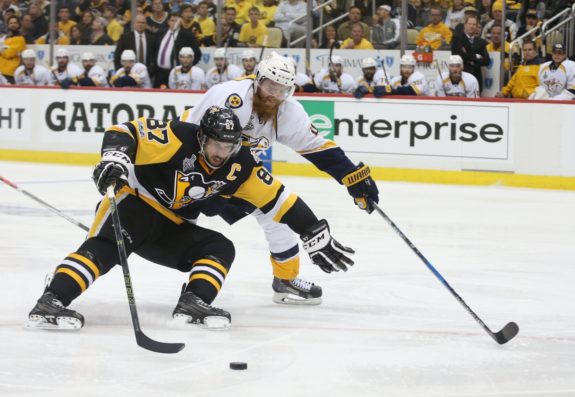Any Pittsburgh Penguins fan probably already knows that he/she should be worried about the team. Although the Penguins currently sit only three points out of a wild-card spot, they’re doing so in a packed division, below five teams that have games in hand. They’re losing key divisional matchups and haven’t been able to cobble together two wins in a row since the beginning of December, when they trounced the Buffalo Sabres two nights in a row.
There are lots of things to be concerned about, but here are four points of their game that are killing the Penguins— all of which have no easy solution for an exhausted team depleted from two successful Stanley Cup runs.
1. Unlucky Shooting Percentage
It’s no secret that the Penguins aren’t scoring; they currently boast a minus-17 goal differential, one of the worst in the league (for reference: only the Panthers, the Canadiens, Senators, Sabres, Canucks, and Coyotes are in worse shape, all of whom are far out of the playoff picture). Captain Sidney Crosby has been criticized for not shooting enough (he is averaging fewer than three shots per game, the lowest season average of his career.

But the problem isn’t that the Penguins aren’t shooting. In fact, the Penguins are fourth in the league in terms of shots per game, averaging 34.31 every match. Unfortunately for the Penguins, however, they are also one of the worst teams in the NHL in terms of shooting accuracy, ranking 28th in the league (again ahead of only the Coyotes, Canadiens and Sabres) with a 7.9-percent shot accuracy.
2. Lack of Even-Strength Scoring
For all their many flaws, the Penguins have the best power play in the league. They convert on over 25 percent of their power plays. On the flip side, they’ve scored the fourth-fewest even-strength goals in the entire league. (For reference, the Penguins have scored 71 even-strength goals so far this season; teams like the Leafs, Knights, Islanders and Lightning have already cleared the 100-goal mark.)

Almost one-third of the Penguins’ goals this season have come on the man advantage. They are having tremendous difficulty scoring at even strength. The fact that they’ve been so successful on the power play— and have had more chances to try it out than almost anyone else, with the fifth-most power play opportunities in the league— has distracted somewhat from how much their five-on-five play has struggled.
3. No Scoring Depth
Only six players on the Penguins’ roster have scored more than five goals so far this season.
How does that compare across the league? The Devils have 12 players above the five-goal threshold. The Hurricanes and the Islanders have 10. The other Metropolitan Division rivals battling for a wild card spot boast significantly more scoring depth than the Penguins, who have been deploying an underperforming fourth line for most of the season. However much they would like to, the Penguins cannot rely on Phil Kessel to score all of their goals for them.
4. Flagging Save Percentage
Matt Murray came into the 2017-18 season as an unquestioned starting goaltender for the first regular season in his young career. Last season, splitting the starts with Marc-Andre Fleury, Murray averaged a .923 save percentage; this season he’s averaging .902, giving the Penguins one of the worst save percentages in the league.

Things get even more concerning for Murray when noting the steep drop-off in his performance after his injury during the last few weeks of November. Since returning on Dec. 14, Murray has averaged a dismal .890 save percentage. That’s not good enough to save a team as defensively weak as this current Penguins lineup is.
The Penguins’ Woes Could Improve
Of course the Penguins should be worried. They’re facing a steep climb ahead of them if they’re looking to claw their way back into a playoff spot. But most of these stats have a chance of regressing. If the Penguins’ shooting percentage starts to climb, they’re going to start putting more pucks in the net. And if Murray starts playing better, or if backup goaltender Tristan Jarry is given more starts and turns out to be reliable, their save percentage will climb as well.

The Penguins’ insurmountable issue may be the problem of roster depth. No eleventh-hour trade is going to solve an utterly exhausted roster. The Penguins’ 5-1 win over the Flyers, where their fourth line tallied two goals, needs to prove to be more than an anomaly to pull the team out of its current rut.